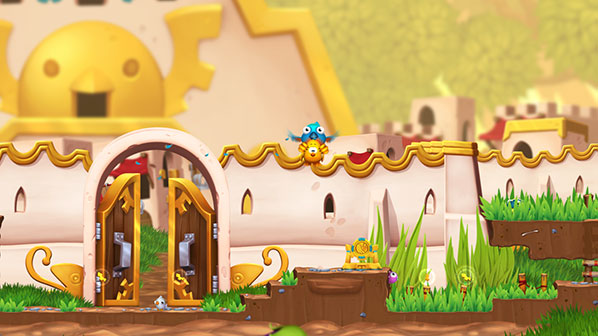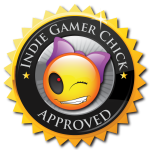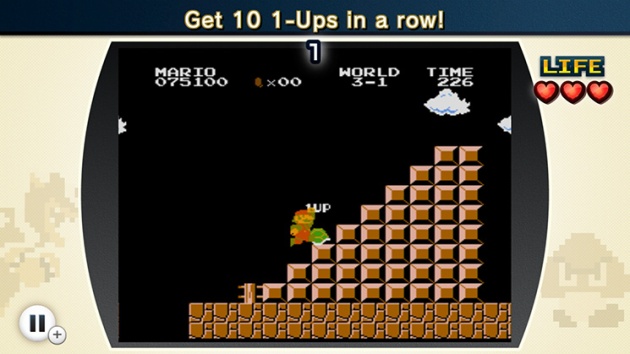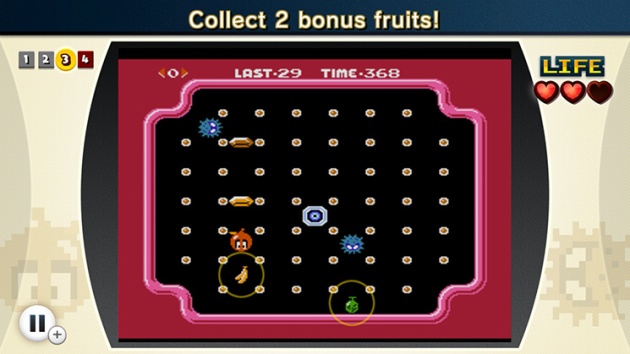January 27, 2014
by Indie Gamer Chick
Something disturbing happened to me recently: I started liking my Wii U. Maybe it has something to do with it finally getting a couple of games I actually wanted to own. No, Nintendo, I’m not really keen on paying $50 for a remake of Wind Waker that you vomited bloom on and called “HD.” I don’t have anything against it, besides the fact that I already played it enough to get a 100% completion when I was thirteen-years-old and thus I had nothing left to get out of it. Hey, if you’re a youngin’ and you’ve never played it, it’s totally worth $50. It’s my favorite Zelda ever. I just can’t understand why people who still own the GameCube original and have beaten it multiple times were drooling at the thought of ponying up $50 to buy it again. The already-spectacular graphics are slightly better, but not another $50 better. The biggest improvement in the game involved REMOVING content. I don’t get it.

Not to mention that if your best game in your first year is a barely upgraded port of a title ten years old, you’re in big trouble.
In fact, “I Don’t Get It” is a running theme with me and my ability to comprehend the Wii U. I’m even more baffled (and somewhat terrified) by how their fans just absolutely will not give you an inch in regards to any flaw in the machine, or accept how damn gloomy the future of the system appears to be. I’m certainly not relishing the idea of my Wii U dying an early death. I look at a video game system as an investment, and with the Wii U, I’ve barely started to get my returns on it. We’re just over a year into its life. Consoles typically don’t hit their stride until year three, year four. I still weep when I think about how the Dreamcast, as good as it was, never really had a “prime” during its existence. In comparison, the Wii U has barely cleared the starting gate, in terms of realizing its potential.
With news that Nintendo slashed the console’s sales forecast by 69%, I’m sure there are people there who are asking “how could this happen?” Even though, before it even launched, pretty much everyone that wasn’t a diehard Nintendo fanboy saw this coming. There are so many factors on why it’s not taking off. I have a few theories on this.
1. The Wii U is just plain not cool. Mock all you want, but the original Wii was, for a time, very cool. Stores could not keep it in stock. Everyone wanted to play it. It was hip and trendy, but simple enough so as not to intimidate anyone. Coolness sells. The iPad is not remotely the best tablet on the market, but it is very cool. So if you have an iPad, you must be cool. When the Wii came out, if you owned one, you were cool. That’s not the case with the Wii U. I’ve seen it myself. We had some teenagers at our Christmas party this year. When they saw I had an iPad, they thought I was cool. When they saw I had both a PlayStation 4 and an Xbox One, they thought I was very cool. When they saw I had a Wii U, they suddenly thought I was a dork with too much disposable income.
Tablets are a big deal now, but tablets are getting increasingly more thin and sleek. Think of the iPad or the Samsung Galaxy. In comparison, the Wii U looks like a Etch-a-Sketch that someone jammed buttons and analog sticks on. A children’s toy, not something high-tech. Then you get to the screen. It’s not a bad screen by any means, but it simply is not as cool as your average tablet. It looks older and outdated, like an early tablet. I mean, it still uses a stylus for God’s sake. Again, the Wii’s controllers, whether you liked them or not, stood out as sleek and novel. The Wii U pad looks like a monstrosity. Nintendo also dropped the ball by not redesigning secondary controllers, instead allowing you to carry over your old Wii remotes. Economically, that made sense. But it reenforced the perception that the Wii U was old and outdated before it even launched.

Ten years ago, this would have been the single coolest thing in gaming history. Now it’s something that people shrug off and say “well, at least it’s not Virtual Boy.”
2. The majority of the utterly insane, never-say-die, ignore all logic and defend Nintendo to the bitter end fanboys are around age 30 and over. I get into it with them all the time on Twitter. Although there are some my age, they’re nowhere near as loud, nor do they work as hard to twist logic and spin facts on the increasing amount of bad news related to the Wii U. Do you wonder why that is? Well, I have an answer. My generation, which some call Millennials, have less brand loyalty than any generation that came before. That is bad news for Nintendo.
Nintendo makes Nintendo-style games. They control the most iconic franchises in gaming. There’s no question that their quality of games are typically pretty high. In the past, they could rely on their franchises and talent to create life-long loyal fans. The fanboys that sometimes annoy me and sometimes amuse me probably got their start in gaming with an NES or an SNES. Those fans stuck with Nintendo every step of the way, through good times and bad. The Virtual Boy sold 140,000 units in the United States. Who do you think bought those? It’s the same way sports fans typically cheer for the local team. It’s what they grew up with, and no matter where they go in life, they always stand by the home team. If you had only an NES as a kid, Nintendo was your local team.
My generation doesn’t do that. That probably has a lot of do with how the delivery of entertainment has evolved over the last thirty years. If you only owned an NES, it didn’t have a lot of competition for your attention. Maybe a handful of cable stations, Saturday morning cartoons, a comic or two once a month, head down to the video store to rent a VHS tape, or play with some He-Man action figures. Today, game consoles compete with the internet, 500+ channel cable and satellite systems with DVR, Netflix, YouTube, smart phones, and tablets. We’re a generation of instant-gratification, where nearly any form of entertainment we want can be accessed instantaneously. So, because we grew up with so many sources of entertainment, we never formed loyalties to any one brand.
Now mind you, the brand loyalty effect is not exclusive to gaming. It’s having a profound effect across the entire entertainment spectrum. But it’s especially bad news for Nintendo. They’ve sustained themselves for over twenty years on the loyal fanbase they created during the NES era. NES children became N64 and GameCube adults, who continue to support the company to this day. The same is not true of those reared on the Nintendo 64 or the GameCube. Companies across the globe are scrambling to adjust their business models around this phenomena. Nintendo is a company notoriously slow to adapt with the times. They were the last company to jump into disc-based storage. The last to embrace online gaming. The last to include high-definition visuals. Just going off their track record, I’m not betting they’ll be fast enough to adjust their marketing strategy to deal with this.

This is a prime example of what I mean. Children of the NES era were so overcome with joy that they nearly died of a cerebral hemorrhage when Dr. Luigi was announced. People my age said “it’s……… seriously, it’s the same fucking game, only you throw two pills into the jar instead of one.” Then the fanboys were like “I KNOW, AWESOME RIGHT! I HOPE IT COMES OUT ON 3DS SO I CAN PAY FOR IT TWICE!”
3. The Wii U is a confusing machine for the general populace. I’ve seen it myself. Let’s go back to that Christmas party earlier. I was showing off all my game consoles to my colleagues and friends, most of whom are much, much older than me. My Wii U game pad’s charging cradle is not situated by the console itself. Nintendo has done well enough marketing it that my partners could identify the pad. “That’s the Wii U, right?” Then they looked at my various new consoles. Xbox One. PlayStation 4. Even the Ouya. Situated somewhere between them was a small, black disc drive that looked like it might be an external component of a PC.
“What’s that?”
“That’s the Wii U.”
“I thought that (pointing at the game pad) was the Wii U.”
“That’s the controller for it. This is the console itself.”
“Oh, it’s one of those.”
Presumably he meant a console. And there in lies the problem: the people who primarily supported the Wii, your casual fanbase looking for a quick-fix good time with friends and family don’t understand what it is. They think it’s a portable device. Or possibly a very expensive accessory for the original Wii. After all, it uses the same controls as the original. And it mostly features the same franchises as seen on the original Wii. If you don’t pay much attention, you might not realize what exactly the Wii U is. I’ve seen it in person.
4. I hate to be one of those people who rags on a machine being underpowered, but the Wii U is too damn underpowered for third-parties to get behind. There’s a myth that having less power makes a console less expensive to develop for. That might be true, if you’re making an exclusive game for the platform. But for blanket multi-platform releases, it’s a huge handicap that might make development for a console cost-prohibitive. Don’t take my word for it. Ask any third-party developer, and they’ll tell you that optimization for less powerful machines takes time and manpower, both of which are expensive. If a developer targets a game for all the current generation systems, making a game play similar on the PS4 and Xbox One will be negligible. Getting that same game to look and play as good on the Wii U will be difficult. I’m not saying it can’t be done. I’m saying it will eat up more company resources to get it done. When a system is already floundering, they might just decide it’s not worth the risk.

Talk about the lack of third-party support of Wii U and, without fail, fanboys will wave Bayonetta 2 in your face like a prized bull. Bayonetta was alright, maybe even good, but it didn’t exactly light the world (or the sales charts) on fire. Going exclusive for Wii U, even if they’re getting paid to do it, seems like suicide. Platinum Games also did Mad World on the Wii, which only sold a little over 100,000 units. They must be gluttons for punishment.
5. Nintendo bungled the launch badly. Having two SKUs for the Wii U, the premium model and the basic model, was simply a bad idea. The basic model, with a pitiful 8 GB of storage and no-game, seemed like a crummy value. However, besides a pack-in game and a charging cradle, the Deluxe model wasn’t that much better. Consumers are number oriented. The basic model was $300 and the Deluxe model was $350. Their competition at the time had packages available for the same price or less that offered 500 GB of storage space. The best version of the Wii U offered a miserable 32 GB. It gave the appearance that the Wii U offered little bang for your buck.
And then you get to the pack-in title for the Deluxe model: Nintendo Land. I’m not knocking the quality of the game. With four friends around, Nintendo Land is a very fun game. But, it sucks to play by yourself. In comparison, Wii Sports was also most potently entertaining with a group of people, but you could have nearly as much fun Wii golfing or Wii bowling by yourself. Nintendo Land’s best games also require you to have the extra controls to play. Wii Sports could be played hot-seat-style. Out of the box, with only one controller, you could play Bowling and Golf. You couldn’t play the other games, but they sucked anyway.
Really, the best option would have been to forgo the basic model, sell the Deluxe version only at a $300 cost, beef up the HDD to at least 100 GB to compete with Sony’s more base models that typically were around 120 GB, and put New Super Mario Bros. U as the pack-in. It was Nintendo’s best-bet as a system-mover. I’m confident that Nintendo Land by itself would have sold very good. In fact, it probably would have sold more copies, because I think the Wii U with Super Mario U as the pack-in would have sold a lot more at launch. Sure, they later did make a bundle that included Mario U and Luigi U, but by that point, the Wii U’s reputation was sealed. The PS4 and XB1 were not too far off, and because there had been a drought of high-quality games in the months following launch, they lost any advantage they might have gotten by being first-to-market. You only get one chance to make a first impression, and Nintendo showed up to the party wearing last season’s clothing and in need of a shower.
6. Why didn’t Nintendo design the system to be compatible with the 3DS? The Wii U itself is basically just a giant DS. They could have made it so the 3DS could act as extra controllers, which could have made for some very novel game concepts. The type of wild, experimental stuff you saw on the GameCube with Final Fantasy Crystal Chronicles, Zelda Four Swords, and Pac-Man Vs.

Hey Nintendo, remember this? How come, now that technology can do all these things wireless and seamlessly, do you not remember it?
7. Nintendo really needs to handle the Virtual Console differently. For many games on PlayStation Network, a single purchase nets you a copy of the game on all Sony platforms that support it. When I cracked open my PS4 on launch day (in the 90 minutes I had before my system bricked and I had to send away for a new one), I immediately owned games like Flower or Sound Shapes for it. I didn’t have to pay one extra cent for them. I bought them on my PS3, and thus I had them on my PS4. When I bought Doki Doki Universe for it, I owned it immediately on my PS3 and Vita as well.
Nintendo’s solution for those that spent oodles of money on Virtual Console stuff? You can have the old versions of them on your Wii U through a convoluted transfer method, but they don’t work with the Wii U Game Pad. If you want that, you have to pay extra. Virtual Console purchases on Wii or Wii U also don’t carry over at all to the 3DS. It makes them seem kind of like cheapskates and makes Sony look like they’re cooler people than Nintendo. In the past, they got away with this, because their fans eagerly repurchased games even if they already owned every single version already out there. Once again, it comes down to the new generation not having that same level of attachment to the company. It’s yet another aspect of the Wii U that makes it appear to not be a good value for your investment.
The sad thing is, this isn’t Monday-morning quarterbacking here. These points were stuff that everybody realized. Everyone, it seems, except Nintendo. I certainly don’t mean to imply that you won’t have fun with a Wii U. After a slow start (Mario U not withstanding, I really did enjoy that game), there are a lot of really good games on the Wii U. I had planned a PlayStation 4 versus Xbox One launch editorial, where the end would have me declare that if I was forced to choose one console to own right now, based on the library of games right now, with no consideration of future potential, I would have chosen the Wii U. And I meant it. As of this writing, it’s still true. The best games available now for the current generation are mostly on it. Nintendo even pulled a rabbit out of their hat late in the year with the surprise release of NES Remix, a game I absolutely adored.

NES Remix is something special. Marry me.
But the future of the system looks pretty bleak, and I don’t know what can be done to turn the tide. At one point, I figured Nintendo would hit the panic button, like they did with the 3DS. A huge price slash, plus an apology-program like the 3DS Ambassador thing for those suckers that bought-in too early. Now, I don’t even think that would help. Nintendo’s loyal fans are in denial about it, but the numbers don’t lie. Nintendo’s own forecast (which, like most companies, will always skew higher than realistic) called for nine-million units sold by 2014’s fiscal year, and instead they revised it to 2.8 million. The PS4 and Xbox One are already primed to pass it, and already have in many regions. It took the PS4 only 48 hours to pass the Wii U in the UK.
Going back to the Dreamcast, I want you to think about where it was at this point in its life-cycle. The shadow of the PlayStation 2 hung over it like a terminal illness. Yet, the Dreamcast was probably in a better position than the Wii U is today. It had a more robust first-party library, and high-quality third-party support. A year later, it was dead, and Sega was releasing games on other platforms. I don’t think Nintendo will go out that way. But the Wii U is not going to suddenly explode. Even if they redesign the pad itself, to make it more in line with sleek and sexy tablets that they seemed to have had in mind in the first place, the system still has too many handicaps. As a Wii U owner, I don’t want my system to go to the grave this early. But all the best games are still somewhere off in the distance, and top-quality third-party games seem practically non-existent. Right now, their big third-party exclusive is Bayonetta 2. A sequel to a game that was decent at best, for a demographic that doesn’t seem in line with the Wii U at all. Really, the fact that Bayonetta 2 is the biggest asset in their bullpen, doesn’t that really tell you everything you need to know? Of course, their fans will disagree with me. They’ll also disagree with the technology. And the sales figures. I just don’t get it.

Thank you everyone for your patience since the start of this month. I’ve got about another month before I learn what my long-term medical situation will be. I’m doing my best to keep gaming and trying to focus on working on Indie Gamer Chick, but it’s really tough. My mind is wandering quite a bit. I appreciate all the well-wishes and support. I’ve had such an outpouring of it that I’m touched on a level I didn’t realize I could be. I do love you all. I don’t plan on going anywhere.




 Blok Drop U and Color Zen are Chick-Approved and ranked on the Indie Gamer Chick Leaderboard.
Blok Drop U and Color Zen are Chick-Approved and ranked on the Indie Gamer Chick Leaderboard.






























 Sigh, can’t believe I’m saying this, but overpriced as heck Little Inferno is
Sigh, can’t believe I’m saying this, but overpriced as heck Little Inferno is 



You must be logged in to post a comment.